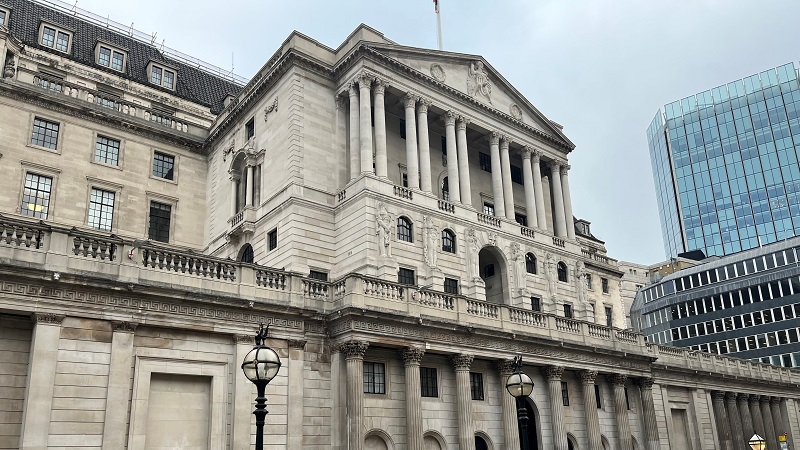The Bank of England has hiked interest rates another 50bps to 4% – its highest level in over a decade.
A majority of Monetary Policy Committee (MPC) members voted 7-2 in favour of the rise, with Swati Dhingra and Silvana Tenreyro both voting for no increase at all – as they had at the last meeting in December.
It marks the tenth MPC meeting in a row to conclude with a rate hike. Before the announcement, interest rates were already at a 14-year high.
In a summary of the decision, the BoE said inflation is ‘likely to have peaked’. However, industry commentators are uncertain if this spells the end of the hiking cycle as a whole, with some anticipating further increases in 2023.
Reacting to the announcement, Blackrock Investment Institute UK chief investment strategist Vivek Paul said: “Today’s 50bps interest rate rise from the BoE gets us closer to the end of the monetary tightening cycle in the UK – but we’re not yet done. As 2023 unfolds, attention will turn to the politics of growth & rates rather than the politics of inflation.
“The damage to the UK’s real economy is only starting to be seen – the effects of the rate hikes are lagged, so the recent near-term growth resilience should not be extrapolated. Despite the bank upgrading its own forecasts, they still forecast a contraction – and we believe the UK will feel more pain than its peers. Inflation is set to fall but, in the long run, will remain above the BoE’s target as supply shortages prevail. High vacancies, low productivity, ageing demographics, and falling forecasted net migration suggest real challenges ahead for Britain.
“Equity investors should consider opportunities elsewhere, for now. Emerging markets have a comparatively better backdrop in the near-run as EM rates peak and China reopens. We remain cautious on UK gilts, preferring short-term US government bonds and investment-grade credit that offer some of the highest yields in the last two decades.”
Emma Mogford, manager for the Premier Miton Monthly Income Fund, said that worker strikes could have fed into the MPC’s decision to hike rates, while Abrdn strategic director Jonny Black suggested rates may rise further to 4.5% over the course of the year.
Karen Ward, chief market strategist Emea at JP Morgan AM, added: “At times like these, the bank has to make the ‘unpopular’ choice. I believe they were right to raise by 50bps today and expect rates to need to increase further, to at least 4.5%, to realign demand and supply and finally tame inflation back towards 2%.”
Fed warns of more to come despite slowing hikes
The BoE’s latest action follows on from the Fed’s own 25bps rise yesterday, bringing the Fed Funds rate range to 4.5%-4.75%.
While the shift down from a 50bps increase at the last Federal Open Market Committee (FOMC) meeting has been described as ‘dovish’, chair Jerome Powell warned of further increases despite the slowing rate of hikes.
Whitney Watson, head of fixed income at Goldman Sachs Asset Management, said: “Easing inflationary pressure and weaker growth signals have set the scene for the Federal Reserve’s decision to slow the pace of rate tightening further today. Guidance on ‘ongoing’ hikes is marginally hawkish, however, further rises of 25bps look set to be status quo from here on given the word ‘pace’ of future increases was replaced with the word ‘extent’.
“While we’re not out of the woods yet, incoming data on wage growth and inflation have been encouraging, including a deceleration in the employment cost index, the Fed’s favoured wage gauge. The path ahead hinges on the labour market rebalancing and this in turn slowing wage growth and core services inflation.
“For investors, the most important takeaway is that the focus in 2023 has shifted from rapidly rising inflation to slowing economic growth. We think this backdrop will see the correlation between bonds and risk assets turn less positive, or even negative. The improved hedging properties of bonds combined with higher income and total return potential presents investors with the most opportunistic environment in fixed income markets in more than a decade, even after the strong performance seen in January.”
There seems to be more to come from the Fed as industry commentators anticipate a terminal rate of over 5% for the US.
Salman Ahmed, Fidelity’s global head of macro & strategic asset allocation, said: “We think the terminal rate is likely to be around 5.25% and [yesterday’s] meeting certainly signals in that direction. The strength in the labour market remains at odd with dynamics in housing and signals from business surveys which indicate an elevated risk of a recession.”
Seema Shah, chief global strategist at Principal Asset Management, added: “The Fed has delivered a reality check to markets, reiterating that while inflation has decelerated, there is still a long road ahead and that long inflation road will take policy rates to at least 5% and likely higher. Certainly, this is an important message to get right.
“The recent loosening in financial conditions threatens to undo much of their good work and raises the spectre of a renewed surge in inflation later this year if the Fed cannot re-gain control of market expectations. The press conference holds the opportunity to hammer home the tighter for longer message.”







